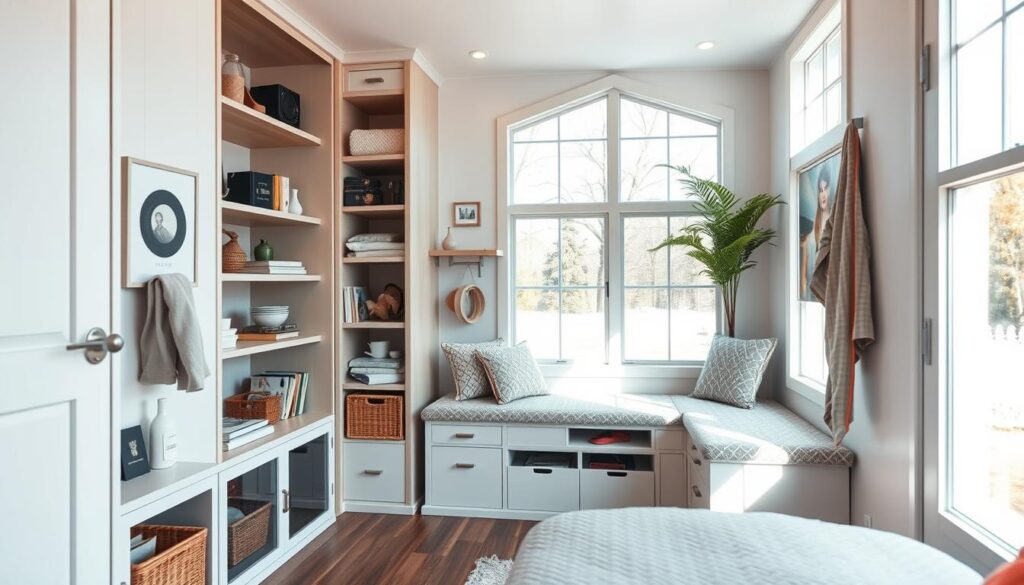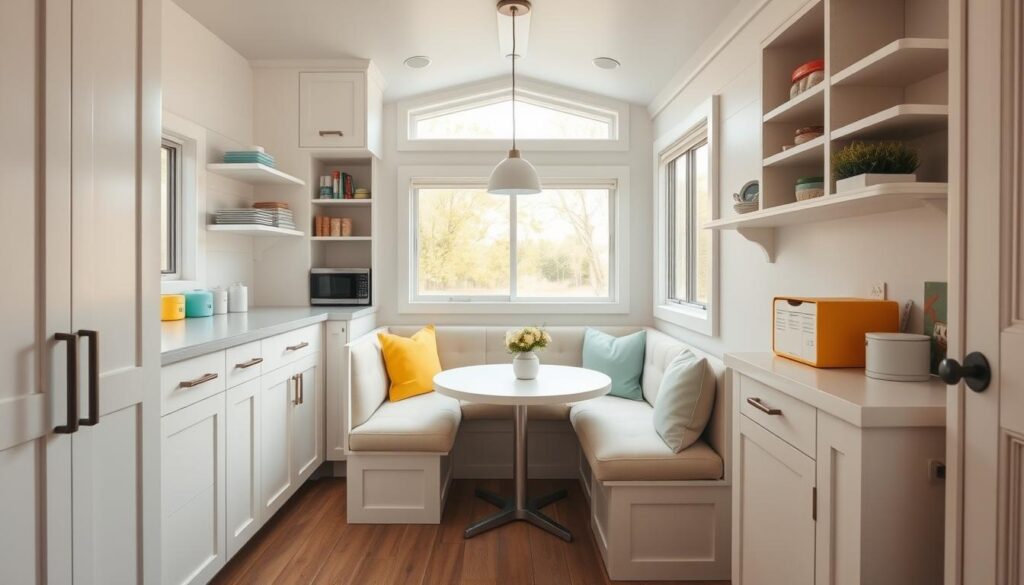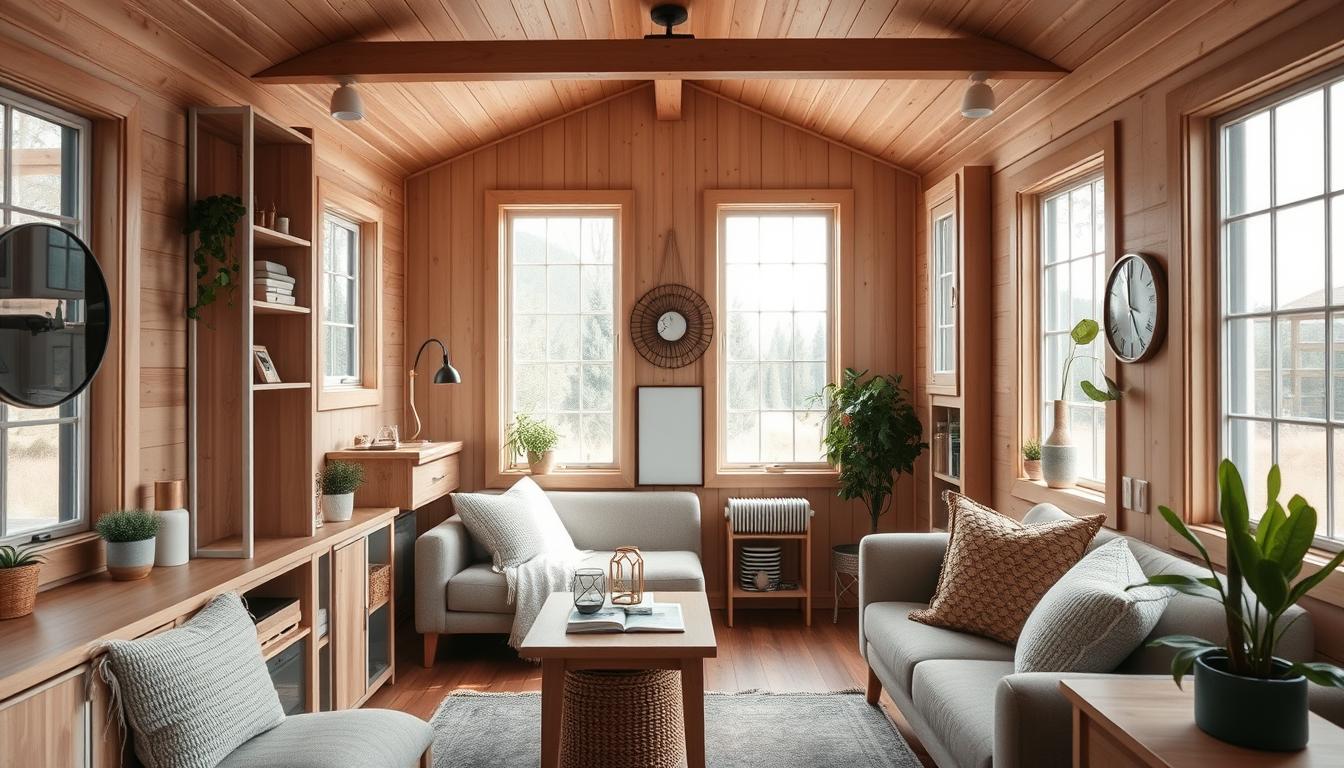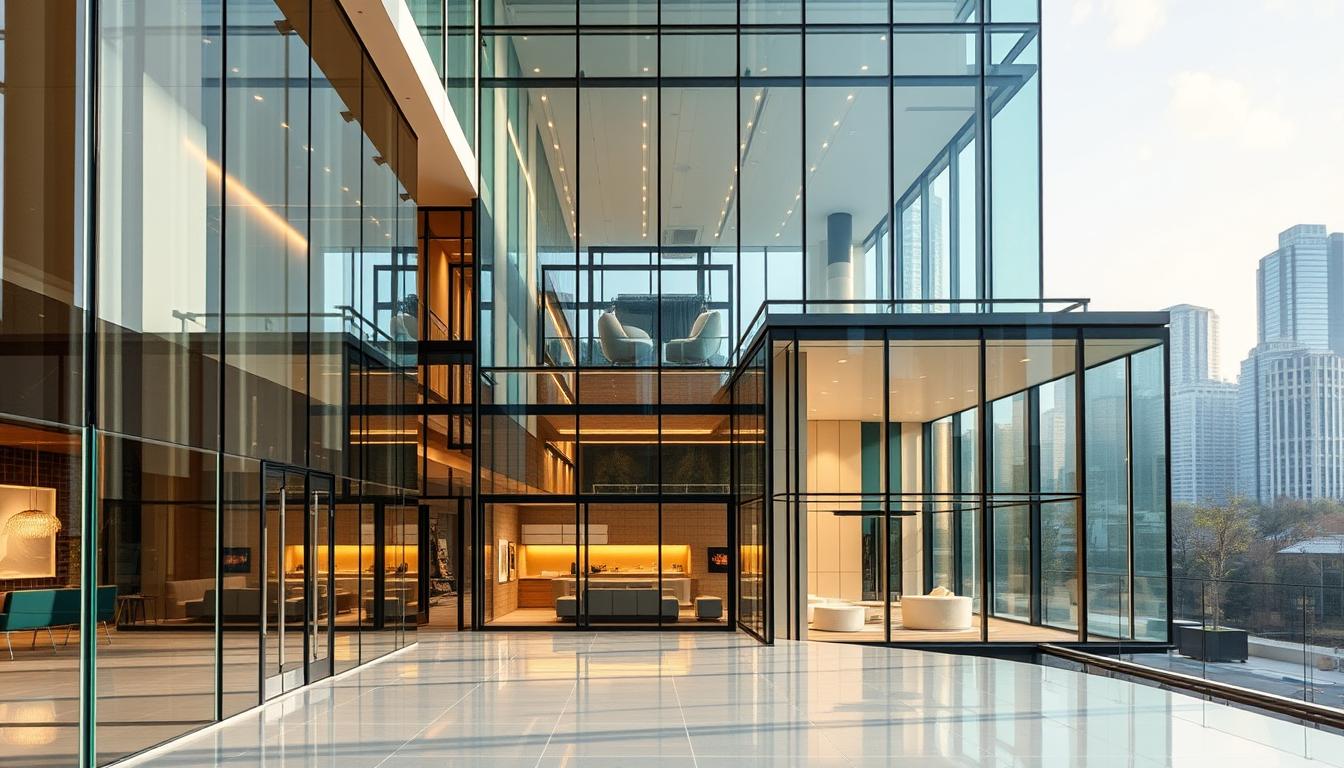Living in a compact dwelling needs creativity and smart thinking. Millions of people are choosing the tiny home lifestyle. It’s not just a passing trend.
We’re sharing our best tiny home interior ideas to help you use your space wisely. You’ll find tips on smart storage and furniture that does more than one thing. These ideas will help you create a cozy and useful living area.
Using these strategies, you can make the most of your tiny home. Enjoy the perks of tiny home living.
Key Takeaways
- Clever storage solutions can greatly enhance your tiny home’s functionality.
- Multi-functional furniture is a must-have for maximizing space.
- Careful planning is essential for creating a comfortable living area.
- Tiny home interior ideas can help you achieve a more organized lifestyle.
- Embracing the tiny home lifestyle requires creativity and resourcefulness.
Understanding Tiny Home Living
To make the most of a tiny home, you need to understand its unique aspects. It’s not just about having a smaller space. It’s about living simply and efficiently.
The Benefits of Downsizing
Downsizing to a tiny home has many advantages. It means less clutter and lower costs. By keeping only what’s essential, you simplify your space and save money. Reduced clutter makes your home more organized and peaceful. And lower expenses give you more financial freedom.
Embracing Minimalism
Minimalism is key in tiny home living. It’s not just about getting rid of stuff. It’s about valuing simplicity and function. By choosing minimalist decor and multi-functional furniture, your home will look good and work well.
This lifestyle makes life simpler and helps you appreciate what’s truly important.
Planning Your Space Efficiently
Creating a cozy living space in a tiny home needs careful planning. We must use every inch wisely to make it both comfortable and functional.
First, think about the layout. A well-planned layout can make your tiny home feel bigger.
Layout Tips for Tiny Homes
When planning your tiny home’s layout, focus on multi-functionality. For example, a sofa bed can be both a place to sit and a bed for guests. This saves space.
- Use sliding doors or curtains to separate areas without taking up too much space.
- Opt for compact furniture that serves more than one purpose.
- Consider a loft bed to free up floor space for other activities.
Zoning Your Living Area
Zoning your living area helps create separate spaces in your tiny home. This approach makes your home feel more organized and cozy.
You can have a cooking zone, a relaxation zone, and a workspace. Each zone has its own look and function.
To zone your space well, use:
- Rugs to mark different areas.
- Lighting to set the mood in each zone.
- Furniture arrangement to guide movement.
By using these strategies, you can make your tiny home more functional and cozy. It becomes a true cozy living space.
Choosing the Right Furniture
Furnishing a tiny home needs careful thought to make the most of space without losing comfort. The furniture you pick is key to making your tiny home functional and cozy.
Multi-Functional Furniture Options
Choosing furniture that does more than one thing is a smart move for tiny homes. These items cut down on clutter and make your space more useful. For example:
- Sofa beds that double as guest beds
- Storage ottomans that provide a place to sit and store items
- Drop-leaf tables that can be expanded when needed and folded away when not in use
As Forbes points out, “Multi-functional furniture is a game-changer for small spaces, offering a practical solution to the challenge of limited square footage.”
“The beauty of multi-functional furniture lies in its ability to adapt to different needs, making it an indispensable element in tiny home design.”
Space-Saving Solutions
There are also other ways to save space in your tiny home. These include:
| Solution | Description | Benefit |
|---|---|---|
| Wall-mounted shelves | Shelves mounted on walls to store books, decorative items, etc. | Frees up floor space, adds storage |
| Nesting tables | Tables that fit inside each other, can be pulled out as needed | Provides additional surface area when needed, saves space when not in use |
| Foldable chairs | Chairs that can be folded and stored away | Reduces clutter, saves space |
By using these creative storage solutions and space-saving furniture pieces, you can make your tiny home both useful and comfy.
Utilizing Vertical Space
Using the vertical space in a tiny home is key to making it more livable. It helps increase storage and keeps the space tidy.
Shelving and Cabinets
Putting up shelving and cabinets that reach the ceiling is smart. It gives lots of room for books, decorations, and kitchen items. It also makes the space look bigger.
Choose shelving and cabinets that match your home’s style. Floating shelves can make it look modern, while traditional cabinets add warmth.
- Opt for adjustable shelving to accommodate items of varying sizes.
- Use stackable containers or baskets on high shelves for storing less frequently used items.
- Incorporate pull-down shelves or foldable tables to enhance functionality.

Hanging Storage Ideas
Hanging storage is another great way to use vertical space. You can hang clothes, utensils, or accessories, keeping them off the floor.
Some good hanging storage ideas are:
- Using over-the-door organizers for hanging shoes, bags, or cleaning supplies.
- Installing a pegboard in the kitchen or workshop area for hanging tools and utensils.
- Employing hanging rod dividers in closets to maximize clothing storage.
By using these ideas, tiny home dwellers can have a more organized and spacious home.
Creative Interior Design Styles
Tiny homes are a blank canvas for creative interior design. They let homeowners show off their style in a small space. The right design can make a tiny home feel big, cozy, or even fancy.
Modern Tiny Home Aesthetics
Modern tiny homes are all about minimalist decor. They focus on simplicity and clean lines. This style is great for those who like a tidy space and want to use their space well.
- Monochromatic color schemes
- Multi-functional furniture
- Abundant natural light
| Design Element | Description | Benefit |
|---|---|---|
| Monochromatic Colors | Using different shades of a single color | Creates a sense of continuity and space |
| Multi-functional Furniture | Furniture that serves more than one purpose | Reduces clutter and increases functionality |
| Natural Light | Maximizing sunlight in the home | Makes the space feel larger and more welcoming |
Rustic and Cozy Vibes
Rustic and cozy vibes can turn a tiny home into a cozy retreat. This style uses natural materials and cozy living elements. It creates a snug atmosphere.
To get a rustic and cozy look, think about adding:
- Reclaimed wood accents
- Soft lighting
- Plush textiles
Choosing a design that fits your taste can make your tiny home both comfortable and stylish.
Color Schemes for Small Spaces
The colors you pick for your tiny home can really change how it looks and feels. The right colors can make your home feel bigger and more welcoming. But, the wrong colors can make it feel small and tight.

Light Colors vs. Dark Colors
In tiny homes, the choice between light and dark colors is a big debate. Light colors are often suggested because they reflect light and make spaces feel open. White, cream, and pale gray can make your tiny home look bigger. On the other hand, dark colors can add warmth and depth, but they can also make a space feel smaller if not used right.
“Light colors can make a room feel larger, but dark colors can add character,” says interior design expert, Jane Smith. “The key is finding a balance that works for your tiny home.”
Creating Visual Illusions
You can also use color to make your tiny home look bigger. One way is to use a monochromatic color scheme, which means using different shades of the same color. This can make your space feel more connected and larger.
- Use lighter shades on walls and ceilings to create a sense of height.
- Apply a slightly darker shade on floors to ground the space.
- Accent walls can be used to add depth without overwhelming the space.
Another way to distract from the tiny home’s small size is to use color. By focusing on certain features or areas, you can shift the attention away from the size. For example, a bold color on a statement piece of furniture can become a focal point, making the room feel more interesting and spacious.
Adding tiny house organization tips and creative storage solutions to your design can also help. By keeping your belongings organized and your storage solutions cleverly hidden, you can keep your space clutter-free and feel more expansive.
Smart Lighting Solutions
Smart lighting is key for tiny homes. It makes small spaces feel bigger and more welcoming. Good lighting improves the mood, function, and health of those living there.
Natural Light Maximization
Getting more natural light is a top goal in tiny home design. Use big windows, skylights, or solar tubes to brighten your home. Natural light cuts down on the need for artificial light and makes spaces feel open and connected to the outdoors.
To get the most natural light, arrange your furniture wisely. Choose light colors for walls and floors to bounce light around.
For more tips on making your tiny home spacious and stylish, see our full guide on tiny home interiors.
Incorporating Smart Lighting
Smart lighting adds to your tiny home’s charm and usefulness. These systems let you change light colors and brightness from your phone. Imagine setting the mood with just a tap on your screen.
- Use LED bulbs for energy savings and long life.
- Install dimmer switches for better light control.
- Layer your lighting with overhead, task, and accent lights for depth and interest.
By mixing natural light with smart lighting, you get a bright, inviting, and practical space. This combo boosts your home’s look and makes it more eco-friendly and cozy.
Personalizing Your Tiny Home
In the world of tiny home living, making it feel like home is key. We’ll explore how to make your small space cozy and inviting.
Adding Personal Touches
Adding personal touches is crucial in making your tiny home feel like home. Use items that hold sentimental value or show your personality. Displaying family photos, heirlooms, or personal collections can warm up your space. It’s about finding a balance between minimalism and personal expression.
When choosing personal items, think about the size of your tiny home. Too many or too big items can clutter it. The goal is to pick your belongings carefully.
Utilizing Artwork and Decor
Artwork and decor are key in personalizing your tiny home. Pick pieces that speak to you to boost your space’s look. Make sure they match your tiny home’s style and color scheme.
In small spaces, a few big pieces work better than many small ones. This keeps your space balanced and uncluttered. Using vertical space for artwork is also smart.
Outdoor Spaces in Tiny Living
Exploring tiny home living means looking at outdoor spaces too. These areas can make our living space bigger and more welcoming. By using the space outside our tiny homes well, we can make our homes feel more open and inviting.
Creating Functional Outdoor Areas
Designing outdoor areas that match our tiny home’s style is key. A patio or deck can be a great extra space for relaxing or having fun. Adding comfy seats, lights, and decorations helps blend indoor and outdoor spaces smoothly.
Ideas for Tiny Home Patios and Decks
There are many ways to make tiny home patios and decks special. We can put in a herb garden, a fire pit, or a dining area. This way, we can enjoy the outdoors and keep our living space tidy and organized.


